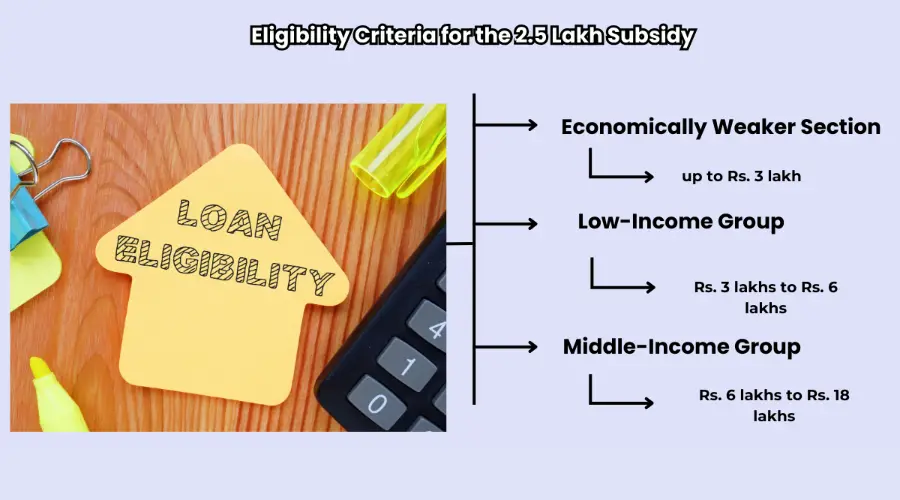The weaker and middle-income sections of society are deprived of owning a house due to the high inflation rate. The increasing inflation rate in real estate obstructs the marginalised sections of society from affording a house in India. Addressing this challenge, in 2015, Pradhan Mantri Awas Yojana was launched by the central government. The main aim or objective of the scheme is to enable an eligible household to own a house by 2022. Under this central government scheme, people are given up to Rupees 2.5 lakh as an interest subsidy to purchase houses through home loans. This article will provide a detailed overview of the 2.5 lakh subsidy for landowners and answer several queries one may have about the scheme.
What is the 2.5 Lakh Subsidy for Land Owners?
The 2.5 lakh subsidy for landowners is an interest subsidy brought by the central government to aid marginalised people in purchasing houses. This interest subsidy is part of the Pradhan Mantri Awas Yojana. The government gives up to Rupees 2.5 lakh as an interest subsidy when an individual attempts to purchase a house through housing loan. The introduction of this scheme gave a fillip to the real estate sector which was reeling under high inflation rate. In addition, if the beneficiary is not interested in taking a loan, the government facilitates the provision of Rupees 1.50 lakh for a house to be built on private land.
Key Benefits of the Subsidy for Land Owners
The main objective of the scheme is to make housing affordable to all sections of society. While the scheme has several advantages, some of the remarkable benefits of implementing this scheme in society are a significant reduction in the overall cost of home ownership and making home ownership accessible to a larger population. Some other key benefits are,
- Reduction in monthly EMIs makes it easier for individuals to repay the loan without any problems because the interest subsidy lowers the interest rate on the home loan directly.
- The interest subsidy makes it possible to pay the loan quickly and expedite the process behind the repayment to own the house sooner.
- This enables people from all walks of life to own a house, providing them with a sense of security and stability. It improves the social and economic status of the people.
- In general, the scheme has created a positive impact on the economy, boosting construction activity, generating employment, and stimulating industries.
- The scheme has brought up the economically weaker sections of society, reducing inequality and promoting social inclusion.
Eligibility Criteria for the 2.5 Lakh Subsidy

There are set criteria that need to be met to become eligible for the scheme. The criteria are based on income levels, property value, and other factors. In terms of income criteria, to become eligible, people from the economically weaker section’s annual income should range up to Rs. 3 lakh, the low-income group’s annual income ranges between Rs. 3 lakhs to Rs. 6 lakhs, and the middle-income group’s ranges between Rs. 6 lakhs to Rs. 18 lakhs. When it comes to property value limits, the limits vary according to the income category, location, and type of property. This interest subsidy can only be availed by first-time homebuyers and the property purchased should be intended for personal purposes, not for commercial purposes.
How the Subsidy Works for Landowners?
While the main purpose of the 2.5 lakh subsidy is to benefit homebuyers purchasing a new house or constructing one. However, in certain cases, this scheme benefits land owners as well only if they intend to build a house on their land. This eligibility criteria may vary with the state government’s guidelines and bank policies. Some states may even provide additional benefits to land owners alongside this 2.5 lakh interest subsidy. Some common procedures followed in the states to extend benefits to the land owner are, securing a home loan from an eligible bank, and submitting the necessary documents under PMAY. If approved, the amount will be credited directly to the loan account.
Conclusion
The Pradhan Mantri Awas Yojana’s (PMAY) interest subsidy for landowners has become a key stepping stone towards achieving the dream of homeownership for millions of Indians. By providing substantial financial assistance, this scheme boosts access and affordability to housing, particularly for the economically weaker sections of society. This subsidy directly benefits individuals and families and contributes to the economy. It boosts the construction industry and creates job opportunities, besides having a positive impact on related sectors. It also ushers in social inclusion, with homeownership empowering individuals and families. The scheme has been quite pragmatic considering its set objectives. But still, the need for regular evaluation and further improvement is there. If bureaucratic barriers, documentation difficulties, and territorial differences are tackled, the effectiveness can be elevated. The government can greatly impact housing and, thus, the nation itself by alleviating the hindrances in the process and broadening the benefits of the subsidy.
FAQs
Following are the steps to apply for a 2.5 Lakh interest subsidy under Pradhan Mantri Awas Yojana (PMAY).
1. Identify a bank or financial company that is part of PMAY.
2. Submit the application form provided by the lender.
3. Cross-checking of information will take place.
4. If every step of the process goes uninterrupted, interest subsidy will be directly credited to your loan account.
Specific documents that are required to avail of the interest subsidy are identity proof, income proof, address proof, land ownership documents, and bank account information.
The time taken may vary depending on the processing time of the lender, the verification process, and the government’s distribution procedures. The approximate period ranges between 4 and 6 months

